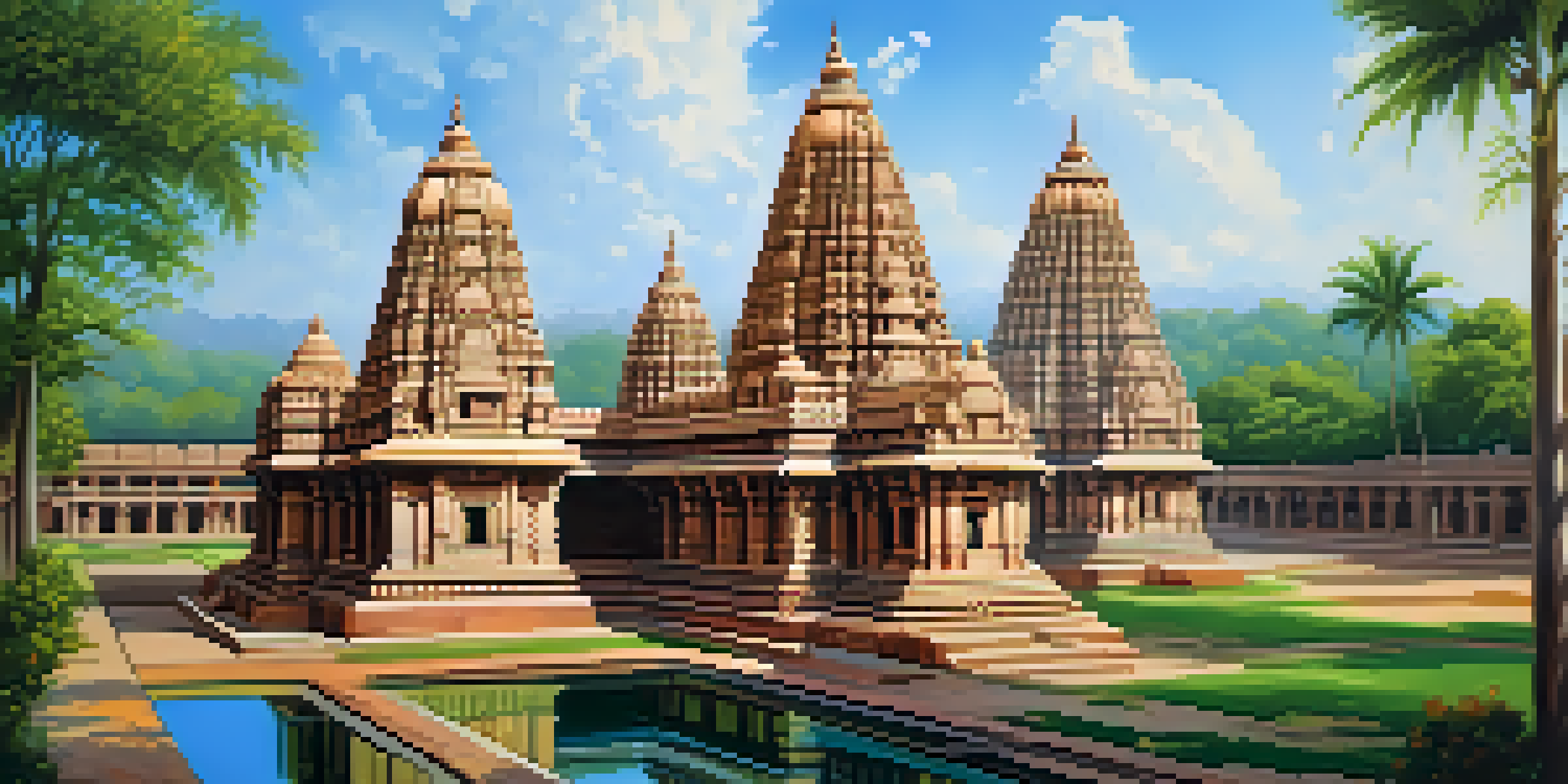Architectural Wonders: Capturing India's Iconic Temples

The Majestic Origins of Indian Temples
Indian temples have a rich history that dates back thousands of years. The earliest structures were often simple, made from wood and clay, evolving into grand stone edifices. Each temple reflects the culture and beliefs of its time, serving as a testament to the artistry of ancient craftsmen.
Architecture is the learned game, correct and magnificent, of forms assembled in the light.
From the intricate carvings to the towering spires, these temples are not just places of worship; they are architectural masterpieces. Temples like the Brihadeeswarar Temple in Tamil Nadu showcase the Dravidian style, characterized by its vast courtyards and intricate sculptures.
Understanding the origins of these temples not only enhances our appreciation of their beauty but also connects us to the spiritual and historical narratives of India. Every stone tells a story, inviting visitors to explore the depths of its significance.
The Spiritual Significance of Temple Architecture
The design of each temple is steeped in spiritual meaning, often grounded in ancient texts like the Vastu Shastra. This traditional Indian system of architecture emphasizes harmony, with the layout aligning with cosmic principles that enhance the spiritual experience.

For instance, many temples are oriented to capture the first rays of the sun, symbolizing enlightenment. The placement of deities within the sanctum sanctorum is meticulously planned to create a sense of divine presence, inviting worshippers to connect with the divine.
Temples as Architectural Masterpieces
Indian temples showcase stunning architecture that reflects the artistry and cultural beliefs of their time.
Thus, every aspect of a temple's architecture is intentional, creating a sacred space where spirituality and artistry converge. This connection makes visiting these temples not just a visual delight, but a profound spiritual journey.
Iconic Temples: A Journey Through Time
India boasts numerous iconic temples, each a reflection of its unique cultural heritage. The Khajuraho temples, famous for their erotic sculptures, highlight the celebration of love and life through art. On the other hand, the ancient Sun Temple of Konark is designed like a colossal chariot, representing the sun god's journey across the sky.
A building is not just a place to be, but a way to be.
Each temple has its own story and significance, making them not just tourist attractions but vital pieces of India's history. The magnificent Hampi ruins showcase the Vijayanagara Empire's architectural prowess, while the golden glow of the Golden Temple in Amritsar offers a serene spiritual experience.
Exploring these temples allows us to travel back in time, providing insights into the socio-political and spiritual dynamics of their eras. They stand as enduring symbols of India's rich past and vibrant culture.
Architectural Styles: Diversity in Design
India's temples are a tapestry of architectural styles, influenced by regional cultures and historical contexts. The Shikhara style, seen in North Indian temples, features a towering spire, while the Dravidian style dominates the South with its pyramid-shaped roofs and elaborate gopurams (gateway towers).
In contrast, the Jain temples of Gujarat exhibit intricate marble work and delicate carvings, highlighting the sect's reverence for craftsmanship. Each style tells a different story about the people who built them, their beliefs, and their artistic expressions.
Spiritual and Community Significance
Temples serve as vital community hubs, fostering spirituality and cultural connections through festivals and rituals.
This diversity in design not only enhances the visual appeal of temples but also enriches the cultural landscape of India. Visitors can appreciate how geography and history have shaped these sacred spaces into unique works of art.
Cultural Festivals: Temples as Community Hubs
Temples in India are not just architectural marvels; they are vibrant centers of community life. Festivals like Diwali, Navratri, and Pongal see temples come alive with celebrations, drawing people from all walks of life. The energy during these festivals transforms the temple grounds into a melting pot of culture, spirituality, and joy.
During these events, the temples are often adorned with flowers, lights, and elaborate decorations, creating a festive atmosphere that enhances their beauty. This communal spirit fosters a sense of belonging, as people gather to celebrate their faith and culture.
These festivals highlight the role of temples in preserving traditions and fostering community ties, making them essential to India's social fabric. They remind us that spirituality is not just a personal journey, but a shared experience that unites people.
Preservation Efforts: Protecting India’s Heritage
As custodians of history, it is crucial to preserve India's iconic temples for future generations. Organizations and governments are increasingly recognizing the importance of conservation, implementing measures to protect these architectural wonders from urbanization and environmental threats.
Restoration projects aim to maintain the integrity of these structures while also adapting them for modern visitors. For instance, the restoration of the Ajanta Caves not only protects the ancient murals but also enhances accessibility for tourists, ensuring that everyone can experience their beauty.
Preservation of Cultural Heritage
Efforts to preserve India's iconic temples are essential for maintaining their historical significance for future generations.
Community involvement plays a vital role in these preservation efforts, as locals often take pride in their heritage. By fostering awareness and appreciation, we can ensure that these temples continue to inspire and educate, preserving their stories for years to come.
Visiting Temples: Tips for Travelers
When planning a visit to India's iconic temples, a few tips can enhance your experience. Dress modestly and respectfully, as many temples have specific dress codes to honor their sacredness. It's also helpful to learn about the temple's history and significance beforehand, allowing you to appreciate its features more deeply.
Consider timing your visit to coincide with festivals or rituals for a more immersive experience. Witnessing aarti (a devotional ritual of worship) or participating in local celebrations can provide unique insights into the temple's cultural context.

Lastly, take your time exploring the surroundings. Many temples are situated in picturesque locales that offer stunning landscapes and rich cultural experiences, making your journey not just about the temples, but a holistic exploration of India's heritage.